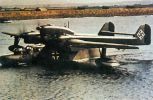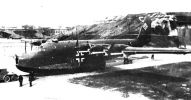
Blohm und Voss BV 138712 viewsThe first prototype which was ready in July 1937 had seveare problems in the air and on the water. A general re-design of the construction followed. Some BV 138 A's were used as transporters for the norwegian campaign in 1940, but late in June 1941 the BV 138 B's saw their service in the role they were constructed for, as sea-reconnaissance planes. From then on they patroled the North-sea and the Arctic-sea and shadowed the well known North-Cape convoys.
The version BV 138 MS was equipped with a mine-sweeping gear and the BV 138 C-1 which was equipped with Radar saw service in anti U-boat attacks.
|
|

Blohm und Voss BV 141653 viewsThe Bv-141 was a very unusual, asymmetric aircraft. The configuration was adopted to give excellent all-round view from a single-engine aircraft. An extensively glazed nacelle was fitted to the left of a slender tail boom. The Bv-141A (with symmetrical tailplane) was an excellent aircraft but the RLM rejected it as underpowered. The more powerful Bv-141B (with asymmetrical tailplane) had some handling problems. Both types had hydraulic problems.
Its first flight, on 25 February 1938, proved the Bv-141 to be more airworthy than its detractors wanted to believe. Over the next two years three Bv-141A prototypes and 10 Bv-141B production aircraft were completed, but the poor bird never shook the stigma of its disfigured appearance and the Folke Wulf Fw-189A was the winner of the contract.
|
|

Blohm und Voss BV 222959 viewsWith a wing span of 46 m and six engines the Blohm & Voss BV 222 was the largest flying boat built in the second world war. On 7th August 1941, the BV 222 V2 which, following experience with the V1, was already equipped with suitable defensive weapons, made it's maiden flight. The first flight took place on 7th September 1940, which was after the start of the second world war, when a machine with a long-range capacity and large cargo space was already of special interest to the military. A total of 12 machines were built in different versions. After completion of trials and conversion, the V2 went into service as a troop transporter with LTS See 222 (air transport command sea 222), before it was finally introduced to 1/SAGr. 129 in Biscarosse, France for the long-range reconnaissance purpose for which it was originally intended.
|
|
|
|